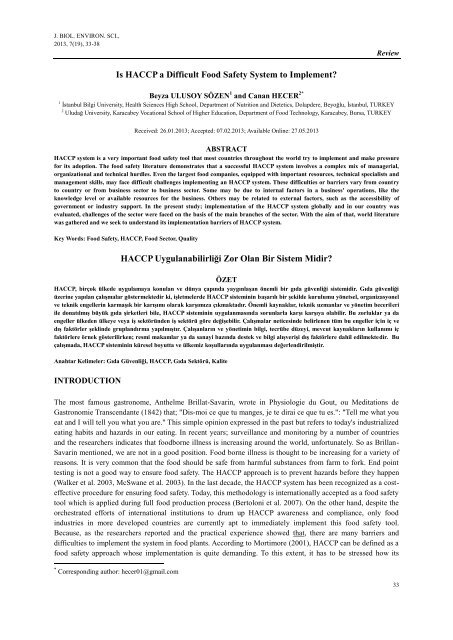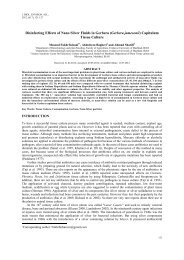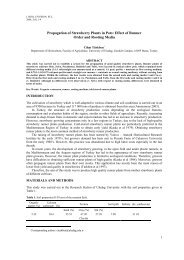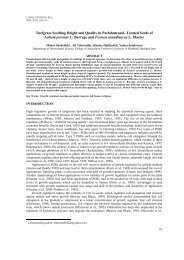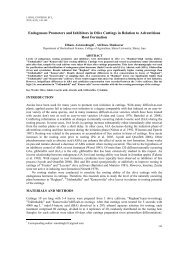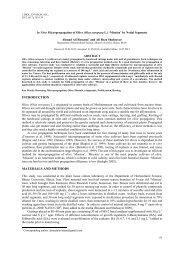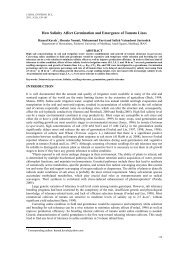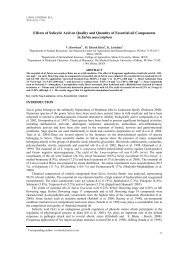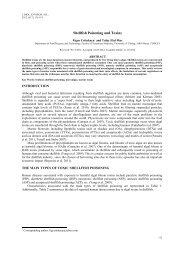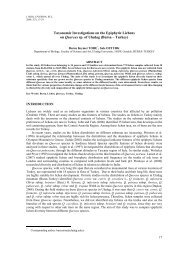Is HACCP a Difficult Food Safety System to Implement? HACCP ...
Is HACCP a Difficult Food Safety System to Implement? HACCP ...
Is HACCP a Difficult Food Safety System to Implement? HACCP ...
Create successful ePaper yourself
Turn your PDF publications into a flip-book with our unique Google optimized e-Paper software.
J. BIOL. ENVIRON. SCI.,<br />
2013, 7(19), 33-38<br />
<strong>Is</strong> <strong>HACCP</strong> a <strong>Difficult</strong> <strong>Food</strong> <strong>Safety</strong> <strong>System</strong> <strong>to</strong> <strong>Implement</strong>?<br />
Review<br />
Beyza ULUSOY SÖZEN 1 and Canan HECER 2*<br />
1 İstanbul Bilgi University, Health Sciences High School, Department of Nutrition and Dietetics, Dolapdere, Beyoğlu, İstanbul, TURKEY<br />
2 Uludağ University, Karacabey Vocational School of Higher Education, Department of <strong>Food</strong> Technology, Karacabey, Bursa, TURKEY<br />
Received: 26.01.2013; Accepted: 07.02.2013; Available Online: 27.05.2013<br />
ABSTRACT<br />
<strong>HACCP</strong> system is a very important food safety <strong>to</strong>ol that most countries throughout the world try <strong>to</strong> implement and make pressure<br />
for its adoption. The food safety literature demonstrates that a successful <strong>HACCP</strong> system involves a complex mix of managerial,<br />
organizational and technical hurdles. Even the largest food companies, equipped with important resources, technical specialists and<br />
management skills, may face difficult challenges implementing an <strong>HACCP</strong> system. These difficulties or barriers vary from country<br />
<strong>to</strong> country or from business sec<strong>to</strong>r <strong>to</strong> business sec<strong>to</strong>r. Some may be due <strong>to</strong> internal fac<strong>to</strong>rs in a business' operations, like the<br />
knowledge level or available resources for the business. Others may be related <strong>to</strong> external fac<strong>to</strong>rs, such as the accessibility of<br />
government or industry support. In the present study; implementation of the <strong>HACCP</strong> system globally and in our country was<br />
evaluated, challenges of the sec<strong>to</strong>r were faced on the basis of the main branches of the sec<strong>to</strong>r. With the aim of that, world literature<br />
was gathered and we seek <strong>to</strong> understand its implementation barriers of <strong>HACCP</strong> system.<br />
Key Words: <strong>Food</strong> <strong>Safety</strong>, <strong>HACCP</strong>, <strong>Food</strong> Sec<strong>to</strong>r, Quality<br />
<strong>HACCP</strong> Uygulanabilirliği Zor Olan Bir Sistem Midir?<br />
ÖZET<br />
<strong>HACCP</strong>, birçok ülkede uygulamaya konulan ve dünya çapında yaygınlaşan önemli bir gıda güvenliği sistemidir. Gıda güvenliği<br />
üzerine yapılan çalışmalar göstermektedir ki, işletmelerde <strong>HACCP</strong> sisteminin başarılı bir şekilde kurulumu yönetsel, organizasyonel<br />
ve teknik engellerin karmaşık bir karışımı olarak karşımıza çıkmaktadır. Önemli kaynaklar, teknik uzmanlar ve yönetim becerileri<br />
ile donatılmış büyük gıda şirketleri bile, <strong>HACCP</strong> sisteminin uygulanmasında sorunlarla karşı karşıya olabilir. Bu zorluklar ya da<br />
engeller ülkeden ülkeye veya iş sektöründen iş sektörü göre değişebilir. Çalışmalar neticesinde belirlenen tüm bu engeller için iç ve<br />
dış faktörler şeklinde gruplandırma yapılmıştır. Çalışanların ve yönetimin bilgi, tecrübe düzeyi, mevcut kaynakların kullanımı iç<br />
faktörlere örnek gösterilirken; resmi makamlar ya da sanayi bazında destek ve bilgi alışverişi dış faktörlere dahil edilmektedir. Bu<br />
çalışmada, <strong>HACCP</strong> sisteminin küresel boyutta ve ülkemiz koşullarında uygulanması değerlendirilmiştir.<br />
Anahtar Kelimeler: Gıda Güvenliği, <strong>HACCP</strong>, Gıda Sektörü, Kalite<br />
INTRODUCTION<br />
The most famous gastronome, Anthelme Brillat-Savarin, wrote in Physiologie du Gout, ou Meditations de<br />
Gastronomie Transcendante (1842) that; "Dis-moi ce que tu manges, je te dirai ce que tu es.": "Tell me what you<br />
eat and I will tell you what you are." This simple opinion expressed in the past but refers <strong>to</strong> <strong>to</strong>day's industrialized<br />
eating habits and hazards in our eating. In recent years; surveillance and moni<strong>to</strong>ring by a number of countries<br />
and the researchers indicates that foodborne illness is increasing around the world, unfortunately. So as Brillan-<br />
Savarin mentioned, we are not in a good position. <strong>Food</strong> borne illness is thought <strong>to</strong> be increasing for a variety of<br />
reasons. It is very common that the food should be safe from harmful substances from farm <strong>to</strong> fork. End point<br />
testing is not a good way <strong>to</strong> ensure food safety. The <strong>HACCP</strong> approach is <strong>to</strong> prevent hazards before they happen<br />
(Walker et al. 2003, McSwane et al. 2003). In the last decade, the <strong>HACCP</strong> system has been recognized as a costeffective<br />
procedure for ensuring food safety. Today, this methodology is internationally accepted as a food safety<br />
<strong>to</strong>ol which is applied during full food production process (Ber<strong>to</strong>loni et al. 2007). On the other hand, despite the<br />
orchestrated efforts of international institutions <strong>to</strong> drum up <strong>HACCP</strong> awareness and compliance, only food<br />
industries in more developed countries are currently apt <strong>to</strong> immediately implement this food safety <strong>to</strong>ol.<br />
Because, as the researchers reported and the practical experience showed that, there are many barriers and<br />
difficulties <strong>to</strong> implement the system in food plants. According <strong>to</strong> Mortimore (2001), <strong>HACCP</strong> can be defined as a<br />
food safety approach whose implementation is quite demanding. To this extent, it has <strong>to</strong> be stressed how its<br />
* Corresponding author: hecer01@gmail.com<br />
33
J. BIOL. ENVIRON. SCI.,<br />
2013, 7(19), 33-38<br />
practical roll out requires a mix of managerial, organizational and technical resources <strong>to</strong> cope with the technical<br />
barriers it presents (Panisello and Quantick 2001). On the other hand, as Sun and Ockerman (2005) mentioned in<br />
their review that it is different <strong>to</strong> apply <strong>HACCP</strong> from big businesses <strong>to</strong> small businesses because the variations in<br />
size of the operations can be tremendous.<br />
With this perspective, we seek <strong>to</strong> understand implementation barriers of <strong>HACCP</strong> system and gathered<br />
world literature reported on this case.<br />
<strong>HACCP</strong> DEVALUATION BY INTERNATIONAL INSTITUTIONS EFFORTS<br />
The system grew out of a need <strong>to</strong> provide safe food for National Aeronautics and Space Administration (NASA),<br />
including the elimination of pathogens, <strong>to</strong>xins, and foreign objects from food and beverages. The application of<br />
<strong>HACCP</strong> was pioneered, during the sixties, by the Pillsbury Company with the cooperation of NASA, Natick<br />
Labora<strong>to</strong>ries of the US Army, and the US Air Force Space Labora<strong>to</strong>ry Project Group. Robert Muller from<br />
Pillsbury Company was the inven<strong>to</strong>r of the <strong>HACCP</strong> standards used by the food industry. The original Pillsbury<br />
<strong>HACCP</strong> procedure has been built up with three components: 1. the identification and assessment of all hazards<br />
associated with the final foodstuff, 2.the identification of the steps or stages within food production at which<br />
these hazards may be controlled, reduced or eliminated: the Critical Control Points (CCPs) and 3. the<br />
implementation of moni<strong>to</strong>ring procedures at these CCPs.<br />
In 1993 the European Union issued Council Directive 43/93 (EU 1993), established a general<br />
requirement for all food business <strong>to</strong> adopt a risk based food safety management system with the principles of<br />
<strong>HACCP</strong>. However, each country in the EU interpreted the Directive in<strong>to</strong> their national regulations in different<br />
ways. This led <strong>to</strong> widely differing levels of interpretation. Because of that Council Regulation 852/2004, with no<br />
option for national amendment, came in<strong>to</strong> force across Europe in January 2006 (EU 2004). It requires all food<br />
businesses <strong>to</strong> implement a system based on <strong>HACCP</strong> principles. The application of <strong>HACCP</strong> has been<br />
incorporated in<strong>to</strong> Codex guidance texts (Codex Alimentarius Commission 1997). Both the United Stated<br />
Department of Agriculture (USDA) and the <strong>Food</strong> and Drug Administration (FDA) has adopted <strong>HACCP</strong> as the<br />
best program <strong>to</strong> prevent food borne illnesses (Eyck et al. 2006). According <strong>to</strong> the National Advisory Committee<br />
on Microbial Criteria for <strong>Food</strong>s, <strong>HACCP</strong> is defined as "a systematic approach <strong>to</strong> identification, evaluation and<br />
control of food safety hazards" and a <strong>HACCP</strong> plan is "the written document which is based upon the principles<br />
of <strong>HACCP</strong> and which delineates the procedures <strong>to</strong> be followed" (NACMCF, 1997). World Health Organization<br />
(WHO) has recognized the importance of the <strong>HACCP</strong> system for the prevention of food borne diseases (WHO,<br />
1997).<br />
Turkey has been a member of <strong>Food</strong> and Agriculture Organization (FAO) and Codex Alimentarius<br />
Commission since 1948. On the other hand, official ordinance regulations on food laws have been fulfilled<br />
according <strong>to</strong> the EU (Hascicek et al. 2004) and by the way Turkey food business was obligated <strong>to</strong> implement<br />
<strong>HACCP</strong> system in food law just like EU member countries. As Bas et al. (2007) mentioned that the use of<br />
<strong>HACCP</strong>, based on the internationally accepted seven principles as promoted by the Codex Alimentarius<br />
Commission, is rapidly increasing in Turkish food businesses.<br />
WHAT IS BEING TALKED ABOUT <strong>HACCP</strong> IMPLEMENTATION BARRIERS<br />
Despite the huge benefits of <strong>HACCP</strong> method, the literature suggests that successful implementation has been<br />
limited by many fac<strong>to</strong>rs. The success in developing, installing, moni<strong>to</strong>ring and verifying a successful <strong>HACCP</strong><br />
system involves a complex mix of managerial, organizational and technical hurdles. Even the big food<br />
companies, may face difficult challenges <strong>to</strong> implement an <strong>HACCP</strong> system. Therefore a small or medium-sized<br />
enterprise (SMEs) may feel that the difficulties of <strong>HACCP</strong> are insurmountable (Taylor 2001). Barriers of time,<br />
money and skilled personnel (Clay<strong>to</strong>n et al. 2002, Hwang et al. 2001, Mortimore, 2001, Panisello et al. 1999)<br />
have been reported by researchers as common fac<strong>to</strong>rs preventing <strong>HACCP</strong> implementation, especially in (SMEs).<br />
The difficulties vary from country <strong>to</strong> country or from business sec<strong>to</strong>r <strong>to</strong> business sec<strong>to</strong>r. Some may be<br />
due <strong>to</strong> internal fac<strong>to</strong>rs operations, like the knowledge level or available resources or some may be related <strong>to</strong><br />
34
J. BIOL. ENVIRON. SCI.,<br />
2013, 7(19), 33-38<br />
external fac<strong>to</strong>rs, such as the accessibility of government or industry support. As Herath and Henson (2010)<br />
mentioned, there are 20 potential barriers for implementation of <strong>HACCP</strong>. The difficulties were expressed with<br />
those statements: “implementation of <strong>HACCP</strong> impeded by internal budgetary constraints, problems obtaining<br />
external funding, current food safety controls considered sufficient, lot of changes <strong>to</strong> our production processes<br />
needed before <strong>HACCP</strong> could be put in place, the things needing <strong>to</strong> be done <strong>to</strong> implement <strong>HACCP</strong> overwhelmed<br />
us, other investments considered more important, lot of changes <strong>to</strong> our food safety controls needed before<br />
<strong>HACCP</strong> could be, wide-scale upgrading of the plant needed before <strong>HACCP</strong> could be put in place put in place,<br />
scale of operation is <strong>to</strong>o small <strong>to</strong> have, not sure whether the implementation of <strong>HACCP</strong> would meet future<br />
regula<strong>to</strong>ry requirements, uncertain about the potential benefits of implementing <strong>HACCP</strong>, <strong>HACCP</strong> difficult <strong>to</strong><br />
implement because of internal organization of the company, concerned that <strong>HACCP</strong> would reduce our flexibility<br />
in production, thought it best <strong>to</strong> wait and see the experiences of other companies before implementing ourselves,<br />
did not really see <strong>HACCP</strong> as suitable for our plant, not sure whether the implementation of <strong>HACCP</strong> would meet<br />
our cus<strong>to</strong>mer’s requirements, considered that costs of implementing <strong>HACCP</strong> likely <strong>to</strong> get cheaper over time,<br />
greater priority given <strong>to</strong> other issues than enhancing our food safety controls, food safety issues not considered<br />
sufficiently important <strong>to</strong> warrant the investment, <strong>HACCP</strong> goes against all of the ways in which we have<br />
traditionally done things”<br />
Obstacles regarding <strong>HACCP</strong> implementation are widespread. Because of that there are numerous<br />
research papers dealing the ways of success <strong>to</strong> adopt the system in various food industries. In an attempt <strong>to</strong> bring<br />
the conclusions of the studies <strong>to</strong>gether, Jevsnik et al. (2006) reported the outcome of a meta-analysis. According<br />
<strong>to</strong> the results, around 50% of the hurdles related <strong>to</strong> training, human resources, planning, knowledge and<br />
competence, and management commitments. 10 of the 12 studies investigated in the meta-analysis reported<br />
barriers related <strong>to</strong> worker motivation, awareness, interest, and familiarity with food safety controls. Other<br />
barriers classified by Jevsnik et al. (2006) relate <strong>to</strong> poor planning of implementation, excessive documentation,<br />
knowledge and competence, external support and lack of resources. The other results of the meta-analysis has<br />
shown that among 21 elements, we can allocate seven elements (training, human resources, planning, knowledge<br />
and competence, management commitment) representing almost 50% of all identified barriers (Jevsnik et al.<br />
2006).<br />
Researchers reported that, in the catering, foodservice and retail industries the most common hurdles<br />
have been classified as lack of knowledge, training, high staff turnover, the large variety of products, change in<br />
potential demand, variability in workloads, and the large numbers of part-time workers (Jevsnik et al. 2007,<br />
Jevsnik et al. 2008, Adams, 2000, Panisello and Quantick 2001, Ward 2001). Studies in hospital food services,<br />
catering establishments, hotels, kebab houses, takeaways and restaurants, have determined that the basic reason<br />
of not developing food safety applications result from the lack of knowledge about these systems (Bas et al.<br />
2007). Walker et al. (2002) quantitatively assessed the generic <strong>HACCP</strong>-PRP implementation in 102 small<br />
medium enterprises in UK. According <strong>to</strong> this study it was reported that 88% of SMEs believed that the minimal<br />
progress in implementing <strong>HACCP</strong> was due <strong>to</strong> the lack of time and expertise. Taylor (2001) observed that even a<br />
large food company, with its resources of money and expertise, might face significant hurdles in developing a<br />
successful <strong>HACCP</strong> system. The results of the study show that the possible fac<strong>to</strong>rs influencing<br />
<strong>HACCP</strong> implementation in hospital kitchens in Taiwan include gender, age, and job position differences as well<br />
as differences in the confidence staff members feel in receiving support from staff in other departments and<br />
financial support from the hospital itself (Shih and Wang 2011). Raspor (2008) determined and reported that<br />
there is rather limited information about <strong>HACCP</strong> systems in Central-European countries. And they surveyed the<br />
situation of the introduction of <strong>HACCP</strong> methods in Slovenia. They investigated that in order <strong>to</strong> run these systems<br />
successfully, two basic conditions: suitable working environment from the hygienic, technical point of view and<br />
motivated, satisfied and qualified personnel must be assured.<br />
Another important barrier for <strong>HACCP</strong> implementation is expensiveness of the system. Martin and<br />
Anderson (1999) evaluated the costs and time for full <strong>HACCP</strong> implementation. According <strong>to</strong> their study; in the<br />
short term, as market requirements for food safety not always were related <strong>to</strong> price improvement and the cost<br />
effectiveness not always was positive <strong>to</strong> the enterprise implementing <strong>HACCP</strong>. However, in the long term, this<br />
implementation might be the only way <strong>to</strong> keep plants as suppliers <strong>to</strong> the food market. Maldonado et al. (2005)<br />
35
J. BIOL. ENVIRON. SCI.,<br />
2013, 7(19), 33-38<br />
concluded that for the Mexican meat industry, investment in new equipment and microbiological tests of<br />
products accounted for most of the implementation and operational costs, respectively. Cala<strong>to</strong>re and Caswell<br />
(1999) reported from studies in the seafood industry that many companies failed <strong>to</strong> have a reliable costs and<br />
benefits estimation of <strong>HACCP</strong> implementation beforehand. They concluded that the uncertainty on costs and<br />
benefits estimations could be a major restrain for planning <strong>HACCP</strong> adoption by individual seafood companies.<br />
In the study of Bas et al. (2007), time and money were identified as the greatest barriers <strong>to</strong> improve food safety.<br />
As they reviewed, similar problems have been reported by other authors (Mortlock et al. 1999, Panisello and<br />
Quantick 2001, Panisello et al. 1999, Ward 2001). Youn and Sneed (2002) identified lack of financial resources<br />
<strong>to</strong> devote <strong>to</strong> food safety was the biggest resource barrier.<br />
As Salay and Caswell (1998) mentioned; <strong>HACCP</strong> implementation requires a complex interrelation<br />
among governments, industry and consumers but unfortunately, this responsibility is not always accomplished.<br />
Yapp and Fairman (2006) indicated a lack of trust in food safety legislation and enforcement officers. Hwang et<br />
al. (2001) found that Indiana school foodservice managers identified time <strong>to</strong> establish a <strong>HACCP</strong> program, time<br />
<strong>to</strong> run the program, and labor costs as being the three biggest obstacles. In addition, “lack of training funds, time<br />
<strong>to</strong> get used <strong>to</strong> running the <strong>HACCP</strong> program, and union problems” were the other identified obstacles. There is a<br />
big confusion between prerequisite programs and <strong>HACCP</strong> plan, their relations and how they should be managed<br />
(Vela & Fernandez, 2003). The main barrier <strong>to</strong> implementing a <strong>HACCP</strong> based food safety management system<br />
was the lack of prerequisite programs as concluded Bas et al. (2006).<br />
Giampaoli et al. (2002) conducted a national study and found three types of barriers: resource<br />
management, employee motivation, and employee confidence. Employees are nervous about taking food safety<br />
certification examinations and often are not comfortable with the change needed for implementation of a<br />
program like <strong>HACCP</strong>. Various studies have shown socio-psychological fac<strong>to</strong>rs <strong>to</strong> influence the implementation<br />
of <strong>HACCP</strong> programs (Ball et al. 2009, Ball et al. 2010, Clay<strong>to</strong>n and Griffith, 2008, Gilling et al. 2001, Hinsz et<br />
al. 2007). Taylor (2008) identifies other psychological barriers such as lack of agreement and lack of selfefficacy.<br />
Similarly, in the study of Garayoa et al. (2011) it was reported that attitude barriers due <strong>to</strong> a lack of<br />
educative courses, sessions or meetings, making it more difficult for workers <strong>to</strong> adhere <strong>to</strong> this system.<br />
Knowledge of the staff was found <strong>to</strong> be important for implementation. Vela and Fernandez (2003)<br />
concluded that; 46.6% of respondents claimed <strong>to</strong> have a good knowledge of <strong>HACCP</strong> while 6.6% admitted <strong>to</strong><br />
having a poor knowledge. Another study has demonstrated that an increase in the knowledge of a food handler<br />
does not necessarily change their food handling behavior and is dependent upon their attitude (Clay<strong>to</strong>n et al.<br />
2002). Panisello and Quantick (2001) identified constant turnover of employees as a barrier. Bas et al. (2007)<br />
concluded in their study that 91% of food business direc<strong>to</strong>rs agreed employees needed more training <strong>to</strong> improve<br />
food safety practices. According <strong>to</strong> their mention; their finding was consistent with the findings of Giampaoli et<br />
al. (2002), Hwang et al. (2001). As Ber<strong>to</strong>loni et al. (2007) mentioned that, <strong>HACCP</strong> can be hindered by lack of<br />
time, expertise, training, motivation, commitment and funding in SMEs. Hwang et al. (2001) also found that the<br />
availability of sanitation training had a positive relationship <strong>to</strong> implementing <strong>HACCP</strong>. Taylor (2001) considered<br />
the employment of experienced, technically qualified food staff as the most important fac<strong>to</strong>r influencing the<br />
implementation of <strong>HACCP</strong> system. Youn and Sneed (2002) identified lack of employee training was the biggest<br />
employee barrier. Lack of financial resources <strong>to</strong> devote <strong>to</strong> food safety was the biggest resource barrier. The<br />
survey results of Walker et al. (2003) in small-and medium-scale food producers underlined the lack of<br />
knowledge. Only 65% of producers kept any records. Their further results, based on questioning of managers,<br />
indicated that the basic lack of hygiene knowledge and understanding could prove <strong>to</strong> be a major barrier <strong>to</strong> the<br />
effective implementation of Bryan (1988) suggested that in the future the number of <strong>HACCP</strong> principles would<br />
increase from seven <strong>to</strong> ten or more. The ninth <strong>HACCP</strong> principle, according <strong>to</strong> him, would be education and<br />
training.<br />
In Turkey the barriers were found similar as reported worldwide. The study of Karaman et al. (2012)<br />
indicates that the most important barriers for food safety systems implementation in the Turkish dairy industry<br />
are due <strong>to</strong> insufficient funds, plant conditions, and knowledge about <strong>HACCP</strong> practices. According <strong>to</strong> a recent<br />
questionnaire study of Bas et al. (2007) in 115 food plants of Ankara, 87% of managers agreed that insufficient<br />
support from the authorities was the biggest problem. The purpose of their study was <strong>to</strong> determine barriers for<br />
36
J. BIOL. ENVIRON. SCI.,<br />
2013, 7(19), 33-38<br />
<strong>HACCP</strong> and food safety programs in food businesses in Turkey and lack of understanding <strong>HACCP</strong> was<br />
identified as one of the main barriers. 63.5% reported that they did not really know what <strong>HACCP</strong> was while<br />
23.5% reported that it was <strong>to</strong>o complicated. Lack of knowledge about <strong>HACCP</strong> (83.5%), lack of time (88.7%),<br />
staff turnover (80.9%), lack of employee motivation (83.5%), complicated terminology (87.0%) and lack of<br />
personnel training (91.3%) was the other most common barriers in food businesses. In some milk plants in Izmir<br />
city, Turkey, it was documented that the critical fac<strong>to</strong>r cited by plant managers for not implementing a <strong>HACCP</strong><br />
system was the high cost of implementation (Demirbas and Karagozlu 2007). On the other hand, the difficulties<br />
of <strong>HACCP</strong> in Turkish food businesses have been named as insufficient equipment and physical conditions of the<br />
food plant (Bas et al. 2006). Within another study performed by Bas et al. (2007), they concluded that the<br />
Turkish Government must develop new regulations on Turkish <strong>Food</strong> Codex and need <strong>to</strong> increase the level of<br />
control in food businesses with respect <strong>to</strong> adaptation law of European Union.<br />
As Garayoa et al. (2011) expressed FAO/WHO report (2006) <strong>to</strong> achieve the successful implementation<br />
of <strong>HACCP</strong>, the concept must be unders<strong>to</strong>od first, by the managers of the establishments.<br />
As a conclusion; it is accepted and reported that there some common and special barriers of<br />
implementing <strong>HACCP</strong> system for many countries. The difficulties vary from country <strong>to</strong> country or from business<br />
sec<strong>to</strong>r <strong>to</strong> business sec<strong>to</strong>r. Especially in Turkey, insufficient funds, plant conditions, and knowledge about<br />
<strong>HACCP</strong> practices are found <strong>to</strong> be the most encountered barriers <strong>to</strong> develop <strong>HACCP</strong> system.<br />
REFERENCES<br />
Adams C (2000). <strong>HACCP</strong> applications in the foodservice industry. Journal of the Association of <strong>Food</strong> and Drug Officials, 94(4): 22-25.<br />
Ball B, Wilcock A and Aung M (2009). Fac<strong>to</strong>rs influencing the implementation of food safety management systems in small and medium<br />
sized meat plants in Ontario, Canada. International Journal of Environmental Health Research, 19(3): 201-218.<br />
Ball B, Wilcock A and Aung M (2010). Background fac<strong>to</strong>rs affecting the implementation of food safety management systems. <strong>Food</strong><br />
Protection Trends, 30(2):, 22-30.<br />
Bas M, Ersun SA and Kivanc G (2006). <strong>Implement</strong>ation of <strong>HACCP</strong> and prerequisite programs in food businesses in Turkey. <strong>Food</strong><br />
Control, 17: 118-126.<br />
Bas M, Yuksel M and Cavusoglu T (2007). <strong>Difficult</strong>ies and barriers for the implementing of <strong>HACCP</strong> and food safety systems in food<br />
businesses in Turkey. <strong>Food</strong> Control, 18: 124-130.<br />
Ber<strong>to</strong>lini M, Rizzi A, Bevilacqua M (2007). An alternative approach <strong>to</strong> <strong>HACCP</strong> system implementation. Journal of <strong>Food</strong> Engineering 79:<br />
1322-1328.<br />
Bryan F (1988). Risks of practices, procedures, and processes that lead <strong>to</strong> outbreaks of foodborne diseases. Journal of <strong>Food</strong> Protection, 51:<br />
663–673.<br />
Brillat-Savarin (1842). Physiologie du gout: ou Méditations de gastronomie transcendante: ouvrage théorique, his<strong>to</strong>rique, et à l'ordre du jour:<br />
dédié aux gastronomes parisiens. Charpentier Libraire-Editeur, Harvard University.<br />
Cala<strong>to</strong>re C and Caswell A J (1999). The cost of <strong>HACCP</strong> implementation in the seafood industry: a case study of breaded fish. In L. J.<br />
Unnevehr (Ed.), The economics of <strong>HACCP</strong>: costs and benefits (pp. 45–68). Minnesota, USA: Eagen Press.<br />
Clay<strong>to</strong>n DA and Griffith C J (2008). Efficacy of an extended theory of planned behavior model for predicting caterers’ hand hygiene<br />
practices. International Journal of Environmental Health Research, 18: 83-98.<br />
Clay<strong>to</strong>n DA, Griffith CJ, Price P and Peters AC (2002). <strong>Food</strong> handlers’ beliefs and self-reported practices. International Journal of<br />
Environmental Health Research, 12:25 – 39.<br />
Codex Alimentarius Commission (1997). Hazard analysis and critical control point (<strong>HACCP</strong>) system and guidelines for its application. <strong>Food</strong><br />
hygiene basic texts. Rome: <strong>Food</strong> and Agriculture Organization.<br />
Demirbas N and Karagozlu C (2007). <strong>HACCP</strong> in the Turkey dairy industry. Agrofood Industry Hi-Tech, 18(3): 36-37.<br />
European Union. (1993). Council Directive 43/93 of 14.6.1993 on the hygiene of foodstuffs. Official Journal of the European Communities,<br />
L175, Brussels.<br />
European Union. (2004). Council Regulation 852/2004 of 29.4.04 on the hygiene of foodstuffs. Official Journal of the European<br />
Communities, L139, Brussels.<br />
Eyck TA, Thede D, Bode G, and Bourquin L (2006). <strong>Is</strong> <strong>HACCP</strong> nothing? A disjoint constitution between inspec<strong>to</strong>rs, processors, and<br />
consumers and the cider industry in Michigan. Agriculture and Human Values, 23: 205-214<br />
FAO/WHO. (2006). FAO/WHO guidance <strong>to</strong> governments on the application of <strong>HACCP</strong> in small and/or less-developed food businesses.<br />
FAO <strong>Food</strong> and Nutrition Paper, 86. Rome<br />
Garayoa R, Vitas AI, Díez-Leturia M and García-Jalón I (2011). <strong>Food</strong> safety and the contract catering companies: <strong>Food</strong> handlers, facilities<br />
and <strong>HACCP</strong> evaluation. <strong>Food</strong> Control 22: 2006-2012.<br />
Giampaoli J, Sneed J, Cluskey M and Koenig HF (2002). School foodservice direc<strong>to</strong>rs’ attitudes and perceived challenges <strong>to</strong> implementing<br />
food safety and <strong>HACCP</strong> programs. The Journal of Child Nutrition & Management, 26(1).<br />
Gilling SJ, Taylor EA, Kane K and Taylor J Z (2001). Successful hazard analysis critical control point implementation in the United<br />
37
J. BIOL. ENVIRON. SCI.,<br />
2013, 7(19), 33-38<br />
Kingdom: understanding the barriers through the use of a behavioral adherence model. Journal of <strong>Food</strong> Protection, 64(5): 710-715.<br />
Hascicek H, Sarimehme<strong>to</strong>flu B and Çakiroflu S (2004). Assessment of the microbiological quality of meals sampled are the meal serving<br />
units of a military hospital in Ankara, Turkey. <strong>Food</strong> Control, 15: 379–384.<br />
Hinsz V B, Nickell G S and Park ES (2007). The role of work habits in the motivation of food safety behaviors. Journal of Experimental<br />
Psychology Applied, 13: 105-114.<br />
Herath D and Henson S (2010).Barriers <strong>to</strong> <strong>HACCP</strong> <strong>Implement</strong>ation: Evidence From the <strong>Food</strong> Processing Sec<strong>to</strong>r in Ontario, Canada.<br />
Agribusiness, 26 (2): 265–279<br />
Hwang JH, Almanza, BA and Nelson DC (2001). Fac<strong>to</strong>rs influencing Indiana school foodservice direc<strong>to</strong>rs/managers’ plans <strong>to</strong> implement a<br />
hazard analysis critical control (<strong>HACCP</strong>) program. The Journal of Child Nutrition & Management, 2: 24–29.<br />
Jevsnik M, Hlebec V and Raspor P (2006). Meta-analysis as a <strong>to</strong>ol for previous term barriers next term identification during previous term<br />
<strong>HACCP</strong> next term implementation <strong>to</strong> improve food safety. Acta Alimentaria, 35(3): 319-353.<br />
Jevsnik M, Bauer M, Zore A and Raspor P (2007). Hygienic status of small and medium sized food enterprises during adoption of <strong>HACCP</strong><br />
system. International Journal of <strong>Food</strong> Science, Technology and Nutrition, 1(1): 95-113.<br />
Jevsnik M, Hlebec V and Raspor, P (2008). <strong>Food</strong> safety knowledge and practices among food handlers in Slovenia. <strong>Food</strong> Control, 19(12):<br />
1107-1118.<br />
Karaman AD, Cobanoglu F, Tunalioglu R, Ova G (2012). Barriers and benefits of the implementation of food safety management systems<br />
among the Turkish dairy industry: A case study. <strong>Food</strong> Control 25, 732-739.<br />
Maldonado ES, Henson SJ, Caswell JA, Leos LA, Martinez PA, Aranda G, Cadena JA (2005). Cost–benefit analysis of <strong>HACCP</strong><br />
implementation in the Mexican meat industry. <strong>Food</strong> Control 16: 375–381.<br />
Martin AS and Anderson WD (1999). <strong>HACCP</strong> adoption in the U.S. food industry. In L. J. Unnevehr (Ed.), The economics of <strong>HACCP</strong>:<br />
costs and benefits (pp. 15–28). Minnesota, USA: Eagen Press.<br />
Mortimore S. (2001). How <strong>to</strong> make <strong>HACCP</strong> really work in practice. <strong>Food</strong> Control, 12: 209-219.<br />
McSwane D., Rue N., and Lin<strong>to</strong>n R. (2003). Essentials of food safety and sanitation (3rd ed.). New Jersey: Pearson Education, pp. 169-196.<br />
NACMCF (National Advisory Committee on Microbiological Criteria for <strong>Food</strong>) (1997). "Hazard analysis and critical control point<br />
principles and application guidelines." Accessed in December 2004 at www-seafood.ucdavis.edu/ Guidelines/nacmcf1.htm.<br />
Panisello PJ, Quantick PC and Knowles M J (1999). Towards the implementation of <strong>HACCP</strong>: Results of a UK regional survey. <strong>Food</strong><br />
Control, 10: 87–90.<br />
Panisello PJ and Quantick CQ (2001). Technical barriers <strong>to</strong> hazard analysis critical control point (<strong>HACCP</strong>). <strong>Food</strong> Control, 12: 165-173.<br />
Pillsbury Company (1973) `<strong>Food</strong> <strong>Safety</strong> Through the Hazard Analysis and Critical Control Point <strong>System</strong>', Contract no. FDA 72-59, Pillsbury<br />
Company, Research & Development Depart- ment, Minneapolis, USA.<br />
Raspor P (2008). Total food chain safety: how good practices can contribute? Trends in <strong>Food</strong> Science and Technology, 19(8): 405-412.<br />
Salay E and Caswell J A (1998). Developments in Brazilian food safety policy. International <strong>Food</strong> and Agribusiness Management Review,<br />
1(2), 167–177.<br />
Shih KM and Wang WK (2011). Fac<strong>to</strong>rs influencing <strong>HACCP</strong> implementation in Taiwanese public hospital kitchens. <strong>Food</strong> Control 22: 496-<br />
500.<br />
Sun YM and Ockerman HW (2005). A review of the needs and current applications of hazard analysis and critical control point (<strong>HACCP</strong>)<br />
system in foodservice areas. <strong>Food</strong> Control 16: 325–332.<br />
Taylor E. (2001). <strong>HACCP</strong> in small companies: benefit or burdens?. <strong>Food</strong> Control, 12: 217–222.<br />
Taylor JZ (2008). <strong>HACCP</strong> for the hospitality industry: a psychological model for success. International Journal of Contemporary Hospitality<br />
Management, 20(5): 508-523.<br />
Vela AR and Ferna´ndez M (2003). Barriers for the developing and implementation of <strong>HACCP</strong> plans: results from a Spanish regional<br />
survey. <strong>Food</strong> Control 14(5):333 – 337.<br />
Walker E, Pritchard C and Forsythe S (2002). Hazard analysis critical control point and prerequisite programme implementation in small and<br />
medium size food businesses. <strong>Food</strong> Control 14(3):169 – 179.<br />
Walker E., Pritchard C. and Forsythe S. (2003). Hazard analysis critical control point and prerequisite programme implementation in small<br />
and medium size food business. <strong>Food</strong> Control, 14: 169-174.<br />
Ward G (2001). <strong>HACCP</strong>: Heaven or hell for the food industry. Quality World (March), 12–15.<br />
WHO (1997). <strong>HACCP</strong>: introducing the hazard analysis and critical control point system WHO/FSF/FOS/97.2. Geneva: World Health<br />
Organization.<br />
Yapp C and Fairman R (2006). Fac<strong>to</strong>rs affecting food safety compliance within small and medium-sized enterprises: implications for<br />
regula<strong>to</strong>ry and enforcement strategies. <strong>Food</strong> Control, 17(1): 42-51.<br />
Youn S and Sneed J (2002). Training and perceived barriers <strong>to</strong> implementing food safety practices in school foodservice. The Journal of<br />
Child Nutrition & Management, 26(2). Available at: .<br />
38


